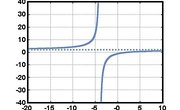
A rational equation contains a fraction with a polynomial in both the numerator and denominator -- for example; the equation y = (x - 2) / (x^2 - x - 2). When graphing rational equations, two important features are the asymptotes and the holes of the graph. Use algebraic techniques to determine the vertical asymptotes and holes of any rational equation so that you can accurately graph it without a calculator.
Factor the polynomials in the numerator and denominator if possible. For example, the denominator in the equation (x - 2) / (x^2 - x - 2) factors to (x - 2)(x + 1). Some polynomials may have any rational factors, such as x^2 + 1.
Set each factor in the denominator equal to zero and solve for the variable. If this factor does not appear in the numerator, then it is a vertical asymptote of the equation. If it does appear in the numerator, then it is a hole in the equation. In the example equation, solving x - 2 = 0 makes x = 2, which is a hole in the graph because the factor (x - 2) is also in the numerator. Solving x + 1 = 0 makes x = -1, which is a vertical asymptote of the equation.
Determine the degree of the polynomials in the numerator and denominator. The degree of a polynomial is equal to its highest exponential value. In the example equation, the degree of the numerator (x - 2) is 1 and the degree of the denominator (x^2 - x - 2) is 2.
Determine the leading coefficients of the two polynomials. The leading coefficient of a polynomial is the constant that is multiplied by the term with highest degree. The leading coefficient of both polynomials in the example equation is 1.
Calculate the horizontal asymptotes of the equation using the following rules: 1) If the degree of the numerator is higher than the degree of the denominator, there are no horizontal asymptotes; 2) if the degree of the denominator is higher, the horizontal asymptote is y = 0; 3) if the degrees are equal, the horizontal asymptote is equal to the ratio of the leading coefficients; 4) if the degree of the numerator is one greater than the degree of the denominator, there is a slant asymptote.
References
About the Author
Karl Wallulis has been writing since 2010. He has written for the Guide to Online Schools website, covering academic and professional topics for young adults looking at higher-education opportunities. Wallulis holds a Bachelor of Arts in psychology from Whitman College.
Photo Credits
BananaStock/BananaStock/Getty Images
